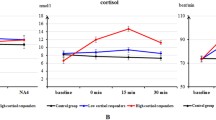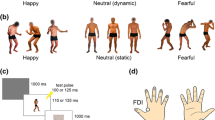Abstract
The (un)predictability of threat influences anticipatory emotional and motivational states. However, few investigations have examined the impact of threat type on defensive motivation. Two within-subject studies (total N = 134) examined defense motivation (startle reflex) and attentional engagement (probe N100, P300) in anticipation of shock and an aversive noise (scream) during a no, predictable, and unpredictable threat (NPU-threat) task. In Study 1, startle was potentiated for unpredictable shock and scream, but potentiation was greater for shock. Startle was potentiated for predictable shock but attenuated for predictable scream. In Study 2, the scream was paired with a scared female face. Startle was potentiated for both predictable and unpredictable shock and scream. The probe N100 was enhanced during unpredictable threat and the probe P300 was suppressed during both predictable and unpredictable threat. The present study suggests that threat type impacts unpredictable (but not predictable) defensive motivation but not attentional engagement. Moreover, predictable auditory aversive stimuli need a paired visual stimulus to enhance defensive motivation.






Similar content being viewed by others
Notes
Startle potentiation for the unpredictable threat condition was averaged across the countdown and interstimulus interval since the participant was in danger during both phases.
As part of the broader experimental session, participants also completed the following self-report measures: Big Five Inventory, Inventory for Depression and Anxiety Symptoms—Expanded Version, Intolerance of Uncertainty Scale, Anxiety Sensitivity Index—3, Intolerance of Uncertainty Index, Penn State Worry Questionnaire, Brief Fear of Negative Evaluation Scale, and Disorder Specific Intolerance of Uncertainty Scale.
Participants also completed retrospective anxiety ratings for each condition; these data were not included in the present study.
Split-half reliability for the startle reflex was determined by calculating the correlation between averages of odd- and even-numbered trials, corrected using the Spearman-Brown prophecy formula (Nunnally et al. 1967). Split-half reliability of startle potentiation (i.e., threat minus no threat) was calculated for each condition using an adjusted formula (Furr and Bacharach 2013). Consistent with previous investigations (Kaye et al. 2016; Nelson and Hajcak 2017b), reliability of the startle reflex was better for the raw score compared to the difference score.
Supplementary analyses indicated no differences between male and female participants on their startle reflex during any condition across Studies 1 and 2.
References
Arnal, L. H., Flinker, A., Kleinschmidt, A., Giraud, A.-L., & Poeppel, D. (2015). Human screams occupy a priveleged niche in the communication Soundscape. Current Biology, 25(15), 2051–2056. https://doi.org/10.1016/j.cub.2015.06.043.Human.
Åsli, O., Michalsen, H., & Øvervoll, M. (2017). In your face: startle to emotional facial expressions depends on face direction. I-Perception, 8(1), 1–13. https://doi.org/10.1177/2041669517694396.
Benjamini, Y., & Hochberg, Y. (1995). Controlling the false discovery rate: A practical and powerful approach to multiple testing. Journal of the Royal Statistical Society, 57, 289–300. https://doi.org/10.2307/2346101.
Bennett, K. P., Dickmann, J. S., & Larson, C. L. (2018). If or when? Uncertainty’s role in anxious anticipation. Psychophysiology, 55(7), 1–15. https://doi.org/10.1111/psyp.13066.
Blumenthal, T. D., Cuthbert, B. N., Filion, D. L., Hackley, S., Lipp, O. V., & Van Boxtel, A. (2005). Committee report: Guidelines for human startle eyeblink electromyographic studies. Psychophysiology, 42, 1–15. https://doi.org/10.1111/j.1469-8986.2005.00271.x.
Bradford, D. E., Shapiro, B. L., & Curtin, J. J. (2013). How bad could it be? Alcohol dampens stress responses to threat of uncertain intensity. Psychological Science, 24(12), 2541–2549. https://doi.org/10.1177/0956797613499923.
Bradford, D. E., Motschman, C. A., Starr, M. J., & Curtin, J. J. (2017). Alcohol’s effects on emotionally motivated attention, defensive reactivity and subjective anxiety during uncertain threats. Social Cognitive and Affective Neuroscience, 12(11), 1823–1832. https://doi.org/10.1093/scan/nsx095.
Bradley, M. M., & Lang, P. J. (2000). Affective reactions to acoustic stimuli. Psychophysiology, 37(2), 204–215. https://doi.org/10.1111/1469-8986.3720204.
Bradley, M. M., Codispoti, M., & Lang, P. J. (2006). A multi-process account of startle modulation during affective perception. Psychophysiology, 43, 486–497. https://doi.org/10.1111/j.1469-8986.2006.00412.x.
Cornwell, B. R., Echiverri, A. M., Covington, M. F., & Grillon, C. (2008). Modality-specific attention under imminent but not remote threat of shock: Evidence from differential prepulse inhibition of startle. Psychological Science, 19(6), 615–622. https://doi.org/10.1038/jid.2014.371.
Cuthbert, B. N., Schupp, H. T., Bradley, M., Mcmanis, M., & Lang, P. J. (1998). Probing affective pictures: Attended startle and tone probes. Psychophysiology, 35(3), 344–347. https://doi.org/10.1017/S0048577298970536.
Dunsmoor, J. E., Bandettini, P. A., & Knight, D. C. (2008). Neural correlates of unconditioned response diminution during Pavlovian conditioning. NeuroImage, 40(2), 811–817. https://doi.org/10.1016/j.neuroimage.2007.11.042.
Furr, R. M., & Bacharach, V. R. (2013). Psychmetrics: An introduction (2nd ed.). Thousand Oaks: Sage Publications.
Glenn, C. R., Lieberman, L., & Hajcak, G. (2012a). Comparing electric shock and a fearful screaming face as unconditioned stimuli for fear learning. International Journal of Psychophysiology, 86, 214–219. https://doi.org/10.1016/j.ijpsycho.2012.09.006.
Glenn, C. R., Lieberman, L., & Hajcak, G. (2012b). Comparing electric shock and a fearful screaming face as unconditioned stimuli for fear learning. International Journal of Psychophysiology, 86(3), 214–219. https://doi.org/10.1016/j.ijpsycho.2012.09.006.
Gorka, S. M., Lieberman, L., Shankman, S. A., & Phan, K. L. (2017). Startle potentiation to uncertain threat as a psychophysiological indicator of fear-based psychopathology: An examination across multiple internalizing disorders. Journal of Abnormal Psychology. https://doi.org/10.1037/abn0000233.
Gratton, G., Coles, M. G. H., & Donchin, E. (1983). A new method for off-line removal of ocular artifact. Electroencephalography and Clinical Neurophysiology, 55(4), 468–484. https://doi.org/10.1016/0013-4694(83)90135-9.
Grillon, C., Ameli, R., Goddard, A., Woods, S. W., & Davis, M. (1994). Baseline and fear-potentiated startle in panic disorder patients. Biological Psychiatry, 35(7), 431–439. https://doi.org/10.1016/0006-3223(94)90040-X.
Grillon, C., Morgan, C. A., Davis, M., & Southwick, S. M. (1998). Effects of experimental context and explicit threat cues on acoustic startle in Vietnam veterans with posttraumatic stress disorder. Biological Psychiatry, 44(10), 1027–1036. https://doi.org/10.1016/S0006-3223(98)00034-1.
Grillon, C., Baas, J. P., Lissek, S., Smith, K., & Milstein, J. (2004). Anxious responses to predictable and unpredictable aversive events. Behavioral Neuroscience, 118(5), 916–924. https://doi.org/10.1037/0735-7044.118.5.916.
Grillon, C., Lissek, S., Rabin, S., McDowell, D., Dvir, S., & Pine, D. S. (2008). Increased anxiety during anticipation of unpredictable but not predictable aversive stimuli as a psychophysiologic marker of panic disorder. American Journal of Psychiatry, 165, 898–904. https://doi.org/10.1176/appi.ajp.2007.07101581.
Grillon, C., Pine, D. S., Lissek, S., Rabin, S., Bonne, O., & Vythilingam, M. (2009). Increased anxiety during anticipation of unpredictable aversive stimuli in posttraumatic stress disorder but not in generalized anxiety disorder. Biological Psychiatry, 66, 47–53. https://doi.org/10.1016/j.biopsych.2008.12.028.
Herbert, C., & Kissler, J. (2010). Motivational priming and processing interrupt: Startle reflex modulation during shallow and deep processing of emotional words. International Journal of Psychophysiology, 76(2), 64–71. https://doi.org/10.1016/j.ijpsycho.2010.02.004.
Herrmann, M. J., Beier, J. S., Simons, B., & Polak, T. (2016). Transcranial direct current stimulation (tDCS) of the right inferior frontal gyrus attenuates skin conductance responses to unpredictable threat conditions. Frontiers in Human Neuroscience, 10(352), 1–6. https://doi.org/10.3389/fnhum.2016.00352.
Herry, C., Bach, D. R., Esposito, F., Di Salle, F., Perrig, W. J., Scheffler, K., et al. (2007). Processing of temporal unpredictability in human and animal amygdala. Journal of Neuroscience, 27(22), 5958–5966. https://doi.org/10.1523/JNEUROSCI.5218-06.2007.
Kaye, J. T., Bradford, D. E., & Curtin, J. J. (2016). Psychometric properties of startle and corrugator response in NPU, affective picture viewing, and resting state tasks. Psychophysiology, 53(8), 1241–1255. https://doi.org/10.1111/psyp.12663.
Lang, P. J. (1995). The emotion probe: Studies of motivation and attention. American Psychologist, 50(5), 372–385.
Lang, P. J., & Bradley, M. M. (2010). Emotion and the motivational brain. Biological Psychology, 84(3), 437–450. https://doi.org/10.1016/j.biopsycho.2009.10.007.
Lau, J. Y. F., Lissek, S., Nelson, E. E., Lee, Y., Roberson-Nay, R., Poeth, K., et al. (2008). Fear conditioning in adolescents with anxiety disorders: Results from a novel experimental paradigm. Journal of the American Academy of Child and Adolescent Psychiatry, 47, 94–102. https://doi.org/10.1097/chi.0b01e31815a5f01.
Lissek, S., Baas, J. M. P., Pine, D. S., Orme, K., Dvir, S., Nugent, M., et al. (2005). Airpuff startle probes: An efficacious and less aversive alternative to white-noise. Biological Psychology, 68, 283–297. https://doi.org/10.1016/j.biopsycho.2004.07.007.
MacNamara, A., & Barley, B. (2018). Event-related potentials to threat of predictable and unpredictable shock. Psychophysiology, 55(10), 1–13. https://doi.org/10.1111/psyp.13206.
Mineka, S., & Kihlstrom, J. F. (1978). Unpredictable and uncontrollable events: A new perspective on experimental neurosis. Journal of Abnormal Psychology, 87(2), 256–271. https://doi.org/10.1037/0021-843X.87.2.256.
Morgan, C. A., Grillon, C., Southwick, S. M., Davis, M., & Charney, D. S. (1995). Fear-potentiated startle in posttraumatic stress disorder. Biological Psychiatry, 38(6), 378–385. https://doi.org/10.1016/0006-3223(94)00321-S.
Näätänen, R., & Picton, T. (1987). The N1 wave of the human electric and magnetic response to sound: A review and an analysis of the component structure. Psychophysiology, 24, 375–425. https://doi.org/10.1111/j.1469-8986.1987.tb00311.x.
Nelson, B. D., & Shankman, S. A. (2011). Does intolerance of uncertainty predict anticipatory startle responses to uncertain threat? International Journal of Psychophysiology, 81, 107–115. https://doi.org/10.1016/j.ijpsycho.2011.05.003.
Nelson, B. D., Hajcak, G., & Shankman, S. A. (2015). Event-related potentials to acoustic startle probes during the anticipation of predictable and unpredictable threat. Psychophysiology, 52, 887–894. https://doi.org/10.1111/psyp.12418.
Nelson, B. D., & Hajcak, G. (2017a). Anxiety and depression symptom dimensions demonstrate unique relationships with the startle reflex in anticipation of unpredictable threat in 8 to 14 year-old girls. Journal of Abnormal Child Psychology, 45(2), 397–410. https://doi.org/10.1007/s10802-016-0169-1.
Nelson, B. D., & Hajcak, G. (2017b). Defensive motivation and attention in anticipation of different types of predictable and unpredictable threat: A startle and event-related potential investigation. Psychophysiology, 54(8), 1180–1194. https://doi.org/10.1111/psyp.12869.
Nunnally, J. C., Bernstein, I. H., & Berge, J. M. T. (1967). Psychometric Theory. New York: McGraw-Hill.
Open Science Collaboration. (2015). Estimating the reproducibility of psychological science. Science, 349(6251), aac4716. https://doi.org/10.1126/science.aac4716.
Parisi, E. A., Hajcak, G., Aneziris, E., & Nelson, B. D. (2017). Effects of anticipated emotional category and temporal predictability on the startle reflex. International Journal of Psychophysiology. https://doi.org/10.1016/j.ijpsycho.2017.03.003.
Polich, J. (2007). Updating P300: An integrative theory of P3a and P3b. Clinical Neurophysiology, 118(10), 2128–2148. https://doi.org/10.1016/j.clinph.2007.04.019.
Rosen, J. B., & Schulkin, J. (1998). From normal fear to pathological anxiety. Psychological Review, 105(2), 325–350.
Schmitz, A., & Grillon, C. (2012). Assessing fear and anxiety in humans using the threat of predictable and unpredictable aversive events (the NPU-threat test). Nature Protocols, 7, 527–532. https://doi.org/10.1038/nprot.2012.001.
Schroijen, M., Fantoni, S., Rivera, C., Vervliet, B., Schruers, K., van den Bergh, O., et al. (2016). Defensive activation to (un)predictable interoceptive threat: The NPU respiratory threat test (NPUr). Psychophysiology, 53, 905–913. https://doi.org/10.1111/psyp.12621.
Shankman, S. A., Robison-Andrew, E. J., Nelson, B. D., Altman, S. E., & Campbell, M. L. (2011). Effects of predictability of shock timing and intensity on aversive responses. International Journal of Psychophysiology : Official Journal of the International Organization of Psychophysiology, 80(2), 112–118. https://doi.org/10.1016/j.ijpsycho.2011.02.008.
Staub, E., Tursky, B., & Schwartz, G. E. (1971). Self-control and predictability: Their effects on reactions to aversive stimulation. Journal of Personality and Social Psychology, 18(2), 157–162. https://doi.org/10.1037/h0030851.
Tottenham, N., Tanaka, J. W., Leon, A. C., McCarry, T., Nurse, M., Hare, T. A., et al. (2009). The NimStim set of facial expressions: Judgments from untrained research participants. Psychiatry Research, 168(3), 242–249. https://doi.org/10.1016/j.psychres.2008.05.006.
Funding
Funding was provided by National Institute of Mental Health (Grant No. K01MH107808).
Author information
Authors and Affiliations
Corresponding author
Ethics declarations
Conflict of interest
The authors declare that they have no conflict of interest.
Ethical approval
All procedures performed in studies involving human participants were in accordance with the ethical standards of Stony Brook University and with the 1964 Helsinki declaration and its later amendments or comparable ethical standards.
Additional information
Publisher's Note
Springer Nature remains neutral with regard to jurisdictional claims in published maps and institutional affiliations.
Rights and permissions
About this article
Cite this article
Ferry, R.A., Nelson, B.D. Differential impact of threat type on defensive motivation and attention during the NPU-threat task. Motiv Emot 44, 670–685 (2020). https://doi.org/10.1007/s11031-020-09835-5
Published:
Issue Date:
DOI: https://doi.org/10.1007/s11031-020-09835-5




